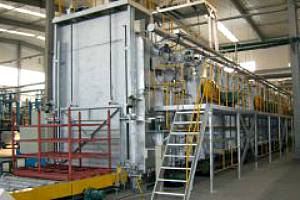Aluminum alloy anodizing equipment

Anodizing equipment:
The metal or alloy article as an anode , electrolysis method so that surface oxidized material film. Metal oxide film changes the surface state and performance, such as surface coloring, improve corrosion resistance, enhance wear resistance and hardness, protect the metal surface.For example, aluminum anodized , aluminum and its alloys in the appropriate electrolyte (such as sulfuric acid, chromic acid, oxalic acid, etc.) as an anode, under certain conditions and the role of the applied current, electrolysis. The aluminum of the anode or its alloy is oxidized to form a thin layer of alumina with a thickness of 5 to 20 m and a hard anodic oxide film of 60 to 200 m on the surface. Anodized aluminum or its alloy, to improve its hardness and wear resistance, up to 250 to 500 kg / mm2, good heat resistance, hard anodic oxide film melting point of up to 2320K, excellent insulation, resistance to attack Wear voltage up to 2000V, enhanced corrosion resistance, in the ω = 0.03NaCl salt spray by thousands of hours without corrosion. Thin film oxide layer has a large number of pores, can absorb all kinds of lubricants, suitable for the manufacture of engine cylinder or other wear parts; membrane adsorption capacity can be colored into a variety of beautiful beautiful bright colors. Non-ferrous metals or their alloys (such as aluminum, magnesium and its alloys, etc.) can be anodized, this method is widely used in mechanical parts, aircraft parts, precision instruments and radio equipment, daily necessities and building decoration and so on. [2] Generally speaking, the anode is aluminum or aluminum alloy as the anode, the cathode is the selection of lead plate, the aluminum and lead plate together in the aqueous solution, there are sulfuric acid, oxalic acid, chromic acid, electrolysis, aluminum And the surface of the lead plate to form an oxide film. Among these acids, the anodic oxidation with sulfuric acid is the most widely used.
Aluminum anodizing production line:
Hard anodizing is a thick anodic oxidation method, which is an aluminum and aluminum alloys special anodized surface treatment process. This process, the maximum thickness of the anodic oxide film up to 250 microns in pure aluminum can be obtained on the 1500kg / mm2 microhardness oxide film, and in the aluminum alloy can be obtained on the 400 ~ 600kg / mm2 significantly Micro - hardness of the oxide film. Its hardness value, the inner layer of the oxide film is larger than the outer layer, that is, the barrier layer is larger than the oxide film layer with the pores, because the oxide film has the loose hole, can absorb all kinds of lubricants, increase the friction reducing ability, the oxide layer thermal conductivity is very Poor, the melting point of 2050 ℃, a large resistivity, the closed treatment (immersion in insulation or paraffin) breakdown voltage up to 2000V, the higher the corrosion resistance in the atmosphere, with high wear resistance, but also a The ideal insulation film layer, also has good insulation, and has a base metal with a solid combination of a series of advantages, so the defense industry and mechanical parts manufacturing industry and its wide range of applications. Mainly used in the requirements of high wear resistance, heat resistance, good insulation properties of aluminum and aluminum parts. Such as the inner wall of the cylinder, the piston, the plug, the cylinder, the bearing, the floor of the cargo hold, the roller and the guide rail, the water conservancy equipment, the steam impeller, the leveling machine, the gear and the cushion. The hard oxidation process is used to replace the traditional hard chrome plating. Compared with the hard chrome process, it has the advantages of low cost, solid film combination, convenient bath and cleaning waste liquid treatment. However, this process is the disadvantage of the film thickness is larger, the aluminum and aluminum alloy mechanical fatigue strength of the impact.